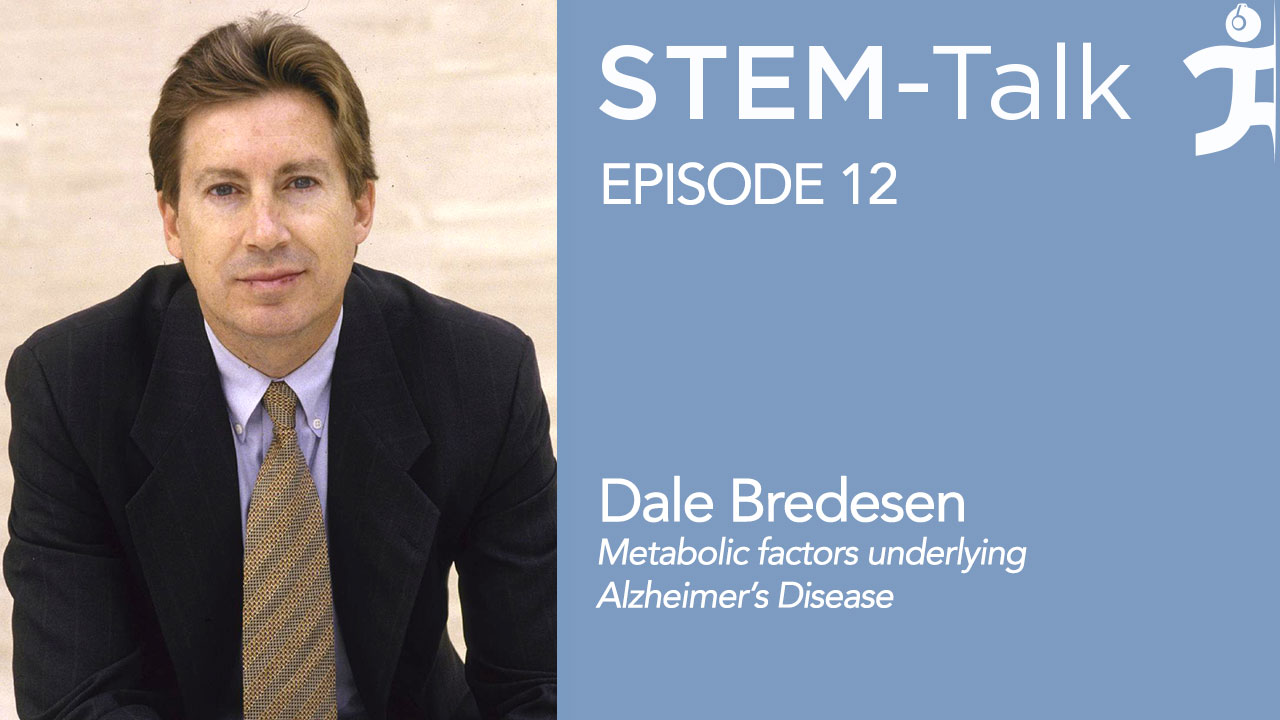STEM-Talk
Episode 12: Dale Bredesen discusses the metabolic factors underlying Alzheimer’s Disease
// May 24, 2016

‘Would you rather remember: the latest episode of Friends, or how to speak?’ asks Dr. Dale Bredesen, a nationally-recognized expert on neurodegenerative diseases.
We don’t have to think about the answer to that question. In fact, we are biologically programmed to preserve speech and forget the television show. But physiological changes occur as we age, which begin to affect our ability to speak, walk, and remember names and faces.
The most extreme and recognizable form of this is Alzheimer’s Disease, which Dr. Bredesen states is the third leading cause of death in the United States. He has come up with a novel therapeutic approach that first investigates the underlying metabolic changes leading to the disease.
Bredesen’s approach, called MEND (metabolic enhancement for neurodegeneration) helped a 65-year-old woman recover her functional memory, after her first physician had written her off as bound to the same demise of her mother, who suffered and died from Alzheimer’s Disease.
Bredesen shares these and other insights in this episode of STEM-Talk, where he and host Dawn Kernagis engage in a rich and thought-provoking conversation about the future of treating neurodegenerative and other diseases.
Bredesen has been on the faculty at UCSF, UCSD. Currently, he divides his time between UCLA and the Buck Institute for Research on Aging, of which he is founder and CEO: http://buckinstitute.org/bredesenLab
For a close-up look at Dr. Bredesen’s work, check out his papers in the Journal Aging: http://www.impactaging.com/papers/v6/n9/full/100690.html ; http://www.impactaging.com/papers/v7/n8/full/100801.html.
As well as is his paper on ApoE4 in the Journal Neuroscience: http://www.ncbi.nlm.nih.gov/pubmed/26791201
00:55: Dawn introduces Dr. Bredesen as a nationally-recognized expert on neurodegenerative diseases such as Alzheimer’s Disease.
1:17: Ford explains that Bredesen’s research has found that AD stems from an imbalance in nerve cell signaling. In the normal brain, specific signals foster memory making, while balancing signals support memory breaking. In AD, the balance of these opposing signals is disturbed. Nerve connections are suppressed, and memories are lost.
1:47: Dawn adds that Bredesen’s findings, which support the view that AD is a metabolically driven, neurodegenerative process, are contrary to the popular belief that the disease is derived from an accumulation of plaques in the brain.
2:50: Ford reads Mark Riff’s 5-star iTunes review: “Fantastic line-up. And what a wealth of cutting edge information. Just having access to these incredible minds is unbelievable. Can’t wait to see what’s coming up.”
3:15: Dawn describes Bredesen’s background: college at Caltech, medical school at Duke University, Chief resident in neurology at UCSF, where he was also a post-doc in Nobel Laureate Stanley Prusiner’s laboratory.
4:02: Bredesen describes how he got into research, first as an undergrad at CalTech. He went to medical school to understand how diseases affect the brain, and specifically alter learning and memory.
4:47: “The whole molecular neuroscience revolution of the 1980s and 1990s has really offered us the novel tools to understand these diseases,” adding that until now, treating and reversing neurodegenerative diseases like Huntington’s and Lou Gehrig’s has been the greatest area of biomedical failure. “This is exciting time where we are starting to develop therapies.”
5:52: The development of large data sets and systems biology is having a major impact on illnesses. People would formerly spend their whole career on one mechanism, but now we’re realizing disease is multi-factorial.
7:05: AD is a network imbalance that is very analogous to osteoporosis. Signals contribute to osteoblastic activity, which is laying down the bones. Other signals contribute to osteoclastic activity, or taking up the bones. For most of our lives, these signals are “beautifully balanced,” which becomes imbalanced as we age. In AD, similarly, synaptoblastic activity is imbalanced with synaptoclastic activity, which destroys synapses.
9:53: Bredesen talks about the “dozens and dozens of signals that alter the synaptic balance” in AD, including: ApoE4, estradiol, Free T3, Free T4, testosterone, exercise, sleep, melatonin.
10:50: AD for most people is not a disease. It is a programmatic downsizing of the synaptic network. Much like apoptosis, or synaptosis. “Imagine you have a company of 10,000 employees that is essentially headed for the red. APP (beta-amyloid precursor protein) is essentially like your CFO who is looking at all inputs. The first thing you do is shut down hiring. First thing in AD is you do not store new memories.”
12:20: You’ve spent your whole life selecting out the most important knowledge, much as we are actively forgetting things all the time.
12:43: AD is three subtypes: two are programmatic downsizing and one is truly an illness.
13:13: Commercial break: STEM-Talk is an educational service of the Florida Institute for Human and Machine Cognition, a not-for-profit research lab pioneering ground-breaking technologies aimed at leveraging human cognition, perception, locomotion and resilience.
16:02: ApoE has turned out to be extremely important, even evolutionarily. When as a species, we transitioned from simians to hominids 5-7 million years ago, an over-representation of inflammatory genes accompanied that change. That is what partly allowed for the transition: We went from being arboreal creatures to roaming the savannah, and fighting with each other/other animals. So we suddenly had to heal wounds and eat microbes in raw meat, which pro-inflammatory genes allowed us to do.
17:30: ApoE4 has conferred certain survival benefits; but it has also increased our risk for AD, cardiovascular disease and is under-represented in centenarians.
19:28: ApoE4 enhances NF-kB and reduces activation of SIRT1.
20:40: ApoE4 helps us during the first forty years of our lives, and if we are living in more challenging, third-world environments. However, later in life, it’s a negative. But it allows you to do well with little food. But bad with too much food.
26:00: With cancer you have tumor suppressor genes and oncogenes; if you have a mutation, you end up with a run-away full forward process of tumor cells.
28:00: Back in 1993, they discovered receptors that respond to withdrawal of trophic support.
30:30: Numerous receptors signal the presence or loss of trophic support.
31:30: APP is an integrating dependence receptor over many of these trophic influences.
32:54: “There is a trophic, anti-trophic balance that is out of balance in people with AD. We can alter this balance in people and make them much, much better.”
33:45: Bredesen describes a 65-year old woman who was having AD symptoms. She consulted Bredesen, who put her on MEND, and three months later, she was back to work, with her memory better than it had been in thirty years.
35:26: You don’t just try to tweak one input, but as many as you can.
36:08: With HIV, it took three drugs to change the landscape of HIV. AD is more complicated.
37:40: This approach works well in all stages, except late stages.
40:10: AD pathophysiology is related to metabolic changes. We start by evaluating the person’s metabolic profile, including: red blood cell magnesium; inorganic and organic mercury status; free and bound testosterone; iodine status. These are things that drive the imbalance.
43:03: People with AD express 10-25 abnormalities; asymptomatic people only express a few.
44:27: Unlike cancer drugs, which often come with side effects, the drugs they are using for these metabolic imbalances in AD first make people feel healthy. The cognitive function follows from the metabolic function.
45:20: AD has been called Type 3 Diabetes.
47:20: For thousands of years we’ve been dealing with small data sets. “But here [with the brain], we are dealing with a very complicated organism. Physicians have had to be intuitive, good guessers.”
48:03: “For 21st century medicine …. The future is for larger and larger data sets, and less and less guesswork.”
49:13: Why did you get this/what’s driving it metabolically? This is a 21st century approach to AD. With so many disparate risk factors, this is not a simple situation.
52:00: Contributing factors include insulin resistance; various inflammatory mediators like NF-kB; hormonal imbalance; exposure to toxins like mercury.
55:20: ApoE4 protects against the third group of AD, which is amyloid positive. It strikes younger people. Agraphia (inability to write) anomias (recall names of common objects)—associated with cortical presentations instead of hippocampal presentations.
58:45: Clinical trials deal with one variable. We have to look at multi-variable and personal trials.
1:02:30: The functional medicine movement looks at the biochemical parameters affecting the underlying problem.
1:04:45: In the early 1800s, a doctor named Ignaz Semmelweis was looking at why women were dying after childbirth, at least those whom medical students had delivered. The women using mid-wives did not die. He discovered that it was because medical students were working on cadavers and were transferring something to the women, so they developed hydrochloride approach to preventing this, and the mortality dropped to almost zero. The point is that small overlooked points in medicine can provide big change.
1:7:00: Commercial break: STEM-Talk is an educational service of the Florida Institute for Human and Machine Cognition, a not-for-profit research lab pioneering ground-breaking technologies aimed at leveraging human cognition, perception, locomotion and resilience.
1:8:05: 75 million Americans are ApoE positive. We should have a national program to get your genome tested and see if you are ApoE positive. “If we initiated this globally, you could dramatically reduce global burden of dementia.”
1:12:42: Bredesen describes his first spark for studying the brain: I was a freshman at CalTech and read the Machinery of the Brain, and I was hooked.
1:14:00: I wanted to go to medical school and study the big picture of driving what’s happening when you get hit in the head, or Huntington’s disease.
1:14:53: There is a schism between 20th century medicine, where you ask what the problem is; and 21st century medicine, where you ask why the problem exists.
1:15:55: The metabolic approach will be the foundation upon which future drug development is based.
1:16:45: Bredesen describes his first aha moment: when he discovered that the receptor that was supposed to be involved in supporting neuronal growth instead induced death.
1:21:25: Bredesen says that over the years, he’s modified his diet, with the help of his wife, an integrative physician, to counter the high simple carb tendency in the American diet.
1:22:22: High stress and little sleep…unquestionably impact AD-related balance.
1:23:44: Dawn thanks Dale.
1:25:07: Dawn and Ken sign off.






